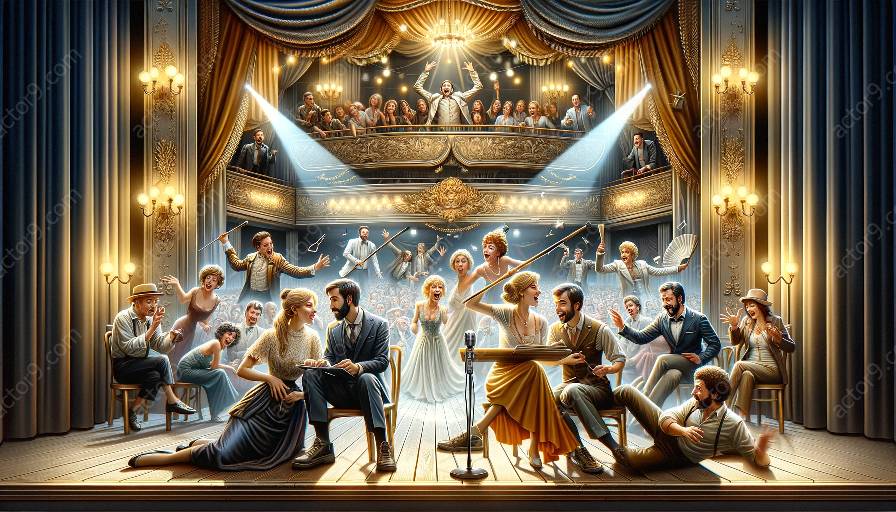Improvisational comedy, or improv, is a form of live theatre in which the plot, characters, and dialogue are created spontaneously. This art form is highly dynamic and engages audiences through humor, creativity, and quick thinking. Within the realm of improvisational comedy, there are several distinct styles that performers employ to entertain and engage with their audience. Understanding these styles can provide valuable insights into the diverse methods and approaches used in the world of improvisation.
1. Short-Form Improvisation
Short-form improvisation is characterized by its quick, often game-based approach. Performers are presented with specific challenges, prompts, or themes, and they must create scenes or scenarios on the spot to address these elements. This style usually involves a series of short games, each with its own set of rules and objectives. The fast pace and varied structure of short-form improv make it an audience favorite, as it offers rapid-fire entertainment and surprises at every turn.
2. Long-Form Improvisation
In contrast to short-form, long-form improvisation allows for more intricate and extended storytelling. Performers use audience suggestions to develop a single, cohesive narrative that unfolds over an extended period. This style often involves multiple characters, interconnected storylines, and thematic exploration. Long-form improv places a greater emphasis on character development, relationships, and organic storytelling, providing a more immersive experience for both performers and audience members.
3. Musical Improvisation
Musical improvisation combines comedy with music, allowing performers to spontaneously create songs, jingles, or musical scenes as part of their performance. This style often involves improvising lyrics, melodies, and vocal harmonies, blending comedy and musical talent in a unique and entertaining manner. Musical improvisation showcases the versatility and creativity of improvisational comedy, adding another layer of entertainment through live music and spontaneous lyricism.
4. Theatrical Improvisation
Theatrical improvisation focuses on the application of improvisational techniques within traditional theatrical settings. Performers use improvisation to enhance scripted plays or to create entirely unscripted theatrical performances. This style encompasses a wide range of approaches, from incorporating improvised dialogue into existing scripts to fully improvised plays that develop in real time based on audience input. Theatrical improvisation allows actors to hone their improvisational skills while engaging with the structure and dynamics of live theatre.
5. Genre-Specific Improvisation
Genre-specific improvisation involves the application of improvisational techniques within specific thematic, stylistic, or genre-based frameworks. Performers may specialize in improvising within genres such as science fiction, fantasy, mystery, or even historical drama. This approach challenges improvisers to embody the conventions and tropes of various genres while incorporating comedic elements. Genre-specific improvisation showcases the adaptability and versatility of improvisational comedy, as performers navigate diverse storytelling landscapes with wit and creativity.
6. Character-Driven Improvisation
Character-driven improvisation focuses on the development and exploration of distinct, memorable characters within improvised scenes and narratives. Performers immerse themselves in the nuances of their characters, infusing each interaction with depth, humor, and unique personality traits. This style emphasizes the art of character creation and portrayal, offering performers the opportunity to showcase their comedic talents through the expressive and comedic personalities they bring to life on stage.
7. Surreal or Absurdist Improvisation
Surreal or absurdist improvisation ventures into the realm of the unexpected and bizarre, drawing inspiration from surrealism, absurdism, and avant-garde theatre. Performers delve into non-linear, abstract storytelling, embracing unconventional narratives, characters, and settings. This style encourages improvisers to embrace the absurd and the nonsensical, creating comedy through the unexpected and the unconventional.
These various styles of improvisational comedy exemplify the rich diversity and creativity within the world of improv. Whether it's the rapid wit of short-form improv, the immersive storytelling of long-form improv, or the fusion of comedy and music in musical improv, each style offers a unique lens through which performers can captivate audiences and express their comedic talents. By exploring and embracing different styles of improvisational comedy, performers can continually expand their artistic horizons and delight audiences with the endless possibilities of spontaneous comedic creation.




























